Do you have a file on your Linux PC that needs to be transferred to your Linux server and you are not sure how to do this? This article teaches you how to copy files via SSH to your remote Linux server. It presents two methods for achieving this file transfer in a secure way. One based on the scp program and one based on the rsync program.
Background
Once you have your own Linux server up and running, you typically access it through SSH. SSH stands for Secure Socket Shell. SSH enables you to securely log in and access your Linux server over an unsecured network. Through SSH you can install, configure and update software on your Linux server, to name just a few common Linux server administration tasks.
While administering you Linux server, sooner or later you run into a situation where you have a file on your own Linux PC and you need to transfer this file to your Linux server. So you SSH-ed into your server and you are staring at your terminal screen, wondering how to go about this task. Unfortunately, you cannot directly transfer a file from your own PC to your remote Linux server through this active SSH terminal session. Luckily though, several methods exist that enable you to copy files via SSH. This article presents you with two of these methods. Namely, by using the scp and rsync programs.
System setup
A typical system setup consists of your Linux desktop PC, connected to your local network router, and a remote Linux server somewhere in the cloud. Instead of setting up a cloud server somewhere for this article (think Digital Ocean or Linode for example) , I decided on running a Linux server as a virtual machine (VM) on my laptop. Below you can find an illustration of the system setup:
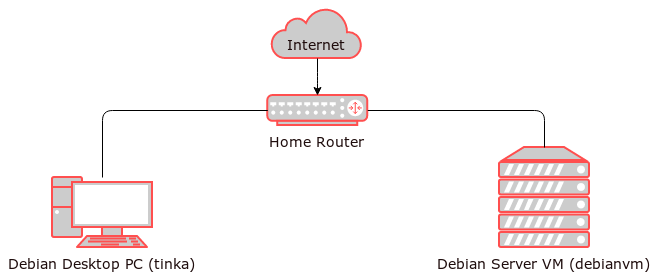
My trusty Lenovo Thinkpad T450s serves as the Desktop PC. I run Debian 10 on this PC and its hostname is set to tinka. The Linux server VM also runs Debian 10 and its hostname is set to debianvm. I configured the same username on both the PC and the server. It is set to pragmalin. Refer to this article in case you would like to setup a similar Debian server as a virtual machine with VirtualBox.
Connecting to your server via SSH
While explaining the steps for copying files to the Debian server via SSH, I’ll occasionally SSH into the Debian server to verify that the files actually got transferred. Here follows a quick refresher that explains how you can log into your server via SSH.
The command from a Linux terminal on your PC to connect to your server is: ssh <username>@ip-address or ssh <username>@hostname. In my case the hostname of the Debian server VM is debianvm . My username on this server is set to pragmalin. This means that I can log into this server via SSH with the command:
ssh pragmalin@debianvm
To close the SSH connection, simply type the exit command:
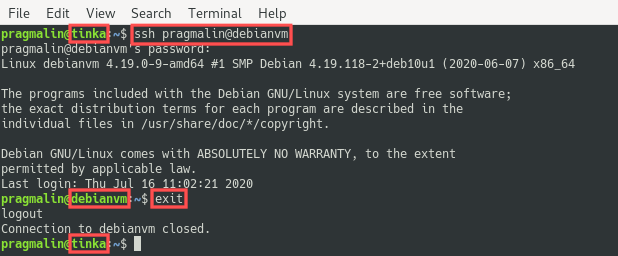
SCP versus RSYNC
Before diving into the actual file copying via SSH, we should discuss the two commonly used programs for this, namely scp and rsync.
The SCP program
The scp program is a secure copy program. So basically a secure and remote version of the cp program that you locally use for copying files. Pretty much all Linux server distributions install the scp program by default, including Debian. Now, if the already installed scp program does all we need then why would we ever need another program for the same task? Read on and you’ll see that rsync does offer some benefits.
The RSYNC program
The rsync program is labeled as a fast, versatile and remote file-copying tool. But it is not just a plain file-copying tool. The rsync program features build-in synchronization functionality. This means that it only copies a file to the remote server if it is not already present. In contrast, the scp program blatantly overwrites the file. Furthermore, rsync can compress the files during the transfer. In other words, rsync is faster and uses less network bandwidth.
By default rsync does not communicate in a secure way. Luckily an easy fix exists for this. You can force rsync to use the SSH protocol by specifying the -e "ssh" option when calling the program. Another minor disadvantage is that rsync is not installed by default on all Linux server distributions. Of course this is merely a one time inconvenience. You can simply install it with sudo apt install rsync. Just keep in mind that the rsync program needs to be installed on both sides. So both on your PC and your server.
When should you use scp and when rsync? They both work, so it partially comes down to personal preference. Personally, I use scp for small quick file transfers as its syntax strikes me as more intuitive. For large file transfers, I opt for rsync, because it is faster and uses less network bandwidth. For example when I need to restore a complete backup to one of my servers.
WordPress archive
For file copy via SSH testing purposes, this article uses the latest WordPress archive. WordPress is a hugely popular website content management system and runs on millions of websites, including the PragmaticLinux blog. We are not actually going to install WordPress, but just use the WordPress files for file copy example purposes.
Go ahead and download the latest WordPress archive from https://wordpress.org/latest.tar.gz. On my PC the file wordpress-5.4.2.tar.gz is now present in directory /home/pragmalin/Downloads/
Copy a single file
Let’s start out with copying just a single file to the server via SSH. Open your terminal and go to the directory that holds to previously downloaded WordPress archive. Next, run either one of the following commands to copy the file to your remote server. Just replace the /home/pragmalin directory name with the name of your home directory on the server and replace the pragmalin@debianvm part with your username on the server and the hostname of the server, respectively:
scp wordpress-5.4.2.tar.gz pragmalin@debianvm:/home/pragmalin
rsync -e "ssh" -avz wordpress-5.4.2.tar.gz pragmalin@debianvm:/home/pragmalin

If you now SSH into your server, you can verify the presence of the wordpress-5.4.2.tar.gz file in your user’s home directory. Both the scp and rsync commands have a similar structure. It is:
[COMMAND] [OPTIONAL ARGUMENTS] [SOURCE] [DESTINATION]
As you can see in this example, the scp program does not require any arguments. However, the rsync program does: -e "ssh" -avz. For detailed information on the command options, you can refer to the program’s man-page. Alternatively, you can make use of the excellent explainshell.com website. Here are the links for an explanation of the previous two commands: scp and rsync.
Permissions
Note that you can only copy files to a directory where the username you specified has write permissions. That is the reason why I specified the home directory in this example. If you need to store the file in a directory where your user does not have write permissions, then you would have to connect to the server via SSH afterwards and move the file with the help of sudo mv.
Reverse transfer direction
You can copy the files via SSH in the other direction too. So from the server to your PC. You just need to swap the [SOURCE] and [DESTINATION] in the command. For example:
scp pragmalin@debianvm:/home/pragmalin/wordpress-5.4.2.tar.gz /home/pragmalin/Downloads
rsync -e "ssh" -avz pragmalin@debianvm:/home/pragmalin/wordpress-5.4.2.tar.gz /home/pragmalin/Downloads
Copy all files in a directory
Another common operation is to copy all the files in a specific directory via SSH. We need a few files to try this out. Since we already downloaded the WordPress archive, we might all well extract its contents to get a bunch of files for testing purposes:
tar -xvf wordpress-5.4.2.tar.gz
For details on how to create and extract TAR GZ archives, refer to this tutorial. The newly created wordpress subdirectory now holds the archive contents. To copy all the files in this directory to your remote server, run either one of the following commands. Just replace the /home/pragmalin directory name with the name of your home directory on the server and replace the pragmalin@debianvm part with your username on the server and the hostname of the server, respectively:
scp * pragmalin@debianvm:/home/pragmalin
rsync -e "ssh" -avz --no-recursive * pragmalin@debianvm:/home/pragmalin
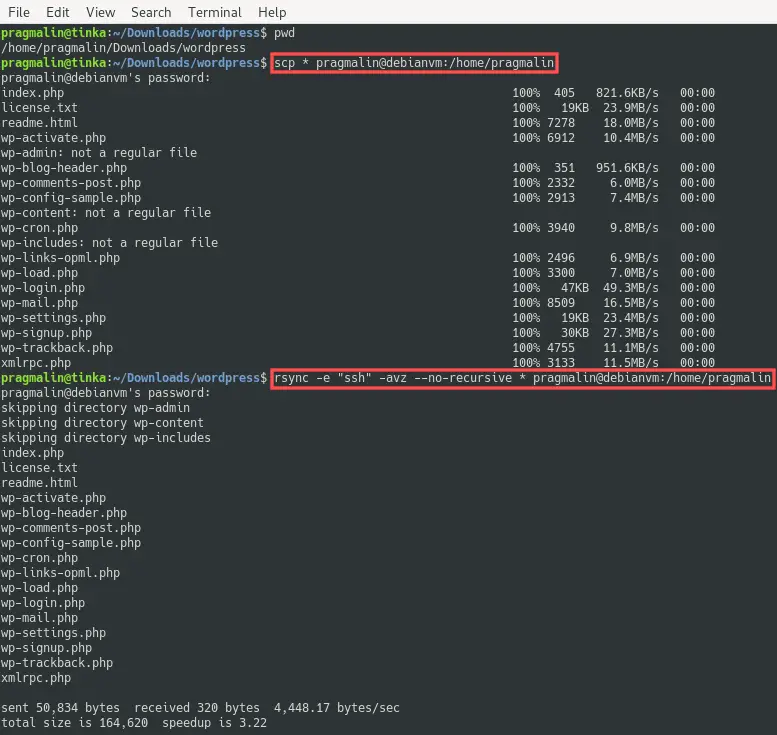
If you now SSH into your server, you can verify the presence of the files such as index.php, wp-config-sample.php, etc. in your user’s home directory.
Copy all files in a directory recursively
In the previous section just the files in a specific directory were copied. This did not include subdirectories. If you want to copy everything, so files and subdirectories, run either one of the following commands. Just replace the /home/pragmalin directory name with the name of your home directory on the server and replace the pragmalin@debianvm part with your username on the server and the hostname of the server, respectively:
scp -r * pragmalin@debianvm:/home/pragmalin
rsync -e "ssh" -avz * pragmalin@debianvm:/home/pragmalin
The output of the command is a bit too long for a screenshot. However the following screenshot from the directory contents listing on the server show proof that the copy operation worked. You can verify the presence of the files such as index.php and wp-config-sample.php, but also all the directories such as wp-admin, wp-contents, etc. in your user’s home directory:
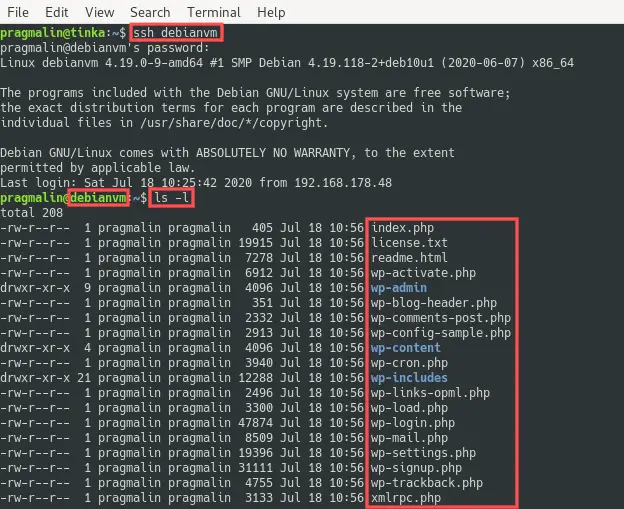
Wrap up
After working through this article, you now know about two programs (scp and rsync) that enable you to copy files via SSH. Both commands get the job done. The syntax of the rsync command is a bit more complicated so you might prefer scp. Keep in mind though that rsync uses less network bandwidth. As a result rsync is faster especially when transferring a large amount of data.
The syntax for both commands is not hard to understand. Nevertheless, it is complex enough that you probably won’t memorize them, unless used frequently. For this reason I recommend bookmarking this article. That way you can quickly reference this information when needed.

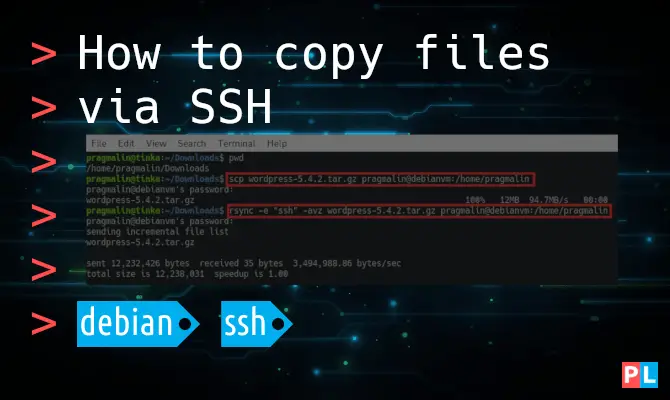



One thought on “How to copy files via SSH”
Comments are closed.